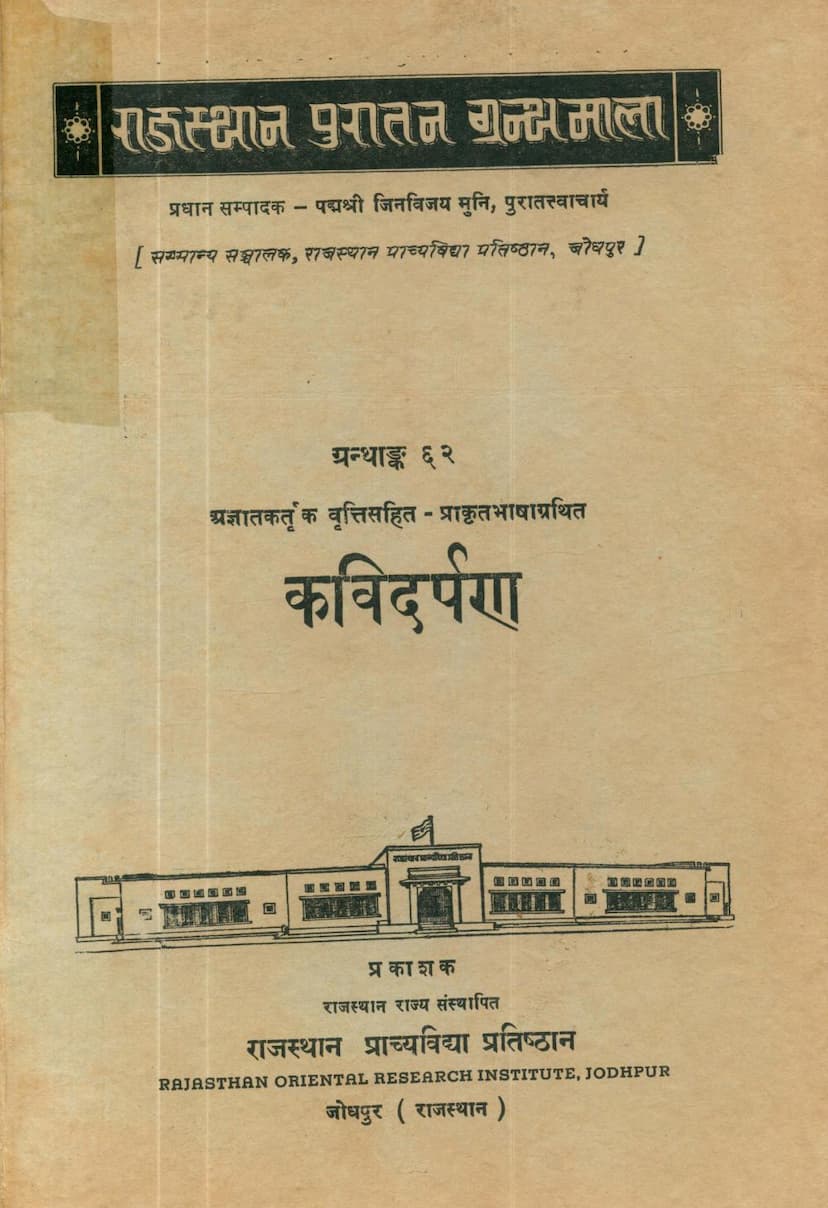Kavidarpan
Added to library: September 2, 2025

Summary
Here's a comprehensive summary of the Jain text "Kavidarpaṇa" by H. D. Velankar, based on the provided information:
Book Title: Kavidarpaṇa (कविदर्पण) Author: Unknown (An unknown Jain author) Commentary Author: Unknown (An unknown Jain commentator) Editor: Prof. H. D. Velankar, M.A. Publisher: Rajasthan Prachyavidya Pratishtana, Jodhpur Series: Rajasthan Puratana Granthamala (राजस्थान पुरातन ग्रन्थमाला), No. 62 Language: Primarily Prakrit (for the text and commentary), with illustrations in Prakrit and Apabhramśa. The introduction and explanations by the editor are in English. Publication Year: VS 2018 / 1962 AD
Overall Summary:
"Kavidarpaṇa" is a significant Jain work on prosody (metrics) written in Prakrit, with a commentary by an unknown Jain author. Edited by Professor H. D. Velankar, this work is crucial for understanding the evolution of Middle Indo-Aryan prosody, particularly focusing on Prakrit and Apabhramśa metres. The book was published by the Rajasthan Oriental Research Institute as part of the Rajasthan Puratana Granthamala series.
Key Aspects and Contents:
-
Nature of the Work: "Kavidarpaṇa" is a comprehensive manual of Prakrit and Apabhramśa metres. It is noted for its detailed classification and treatment of various metrical forms, especially those prevalent among popular bards. While it covers Varna Vrttas (syllable-based metres) as well, its primary focus is on Mātrā Vrttas (mora-based metres) of Prakrit and Apabhramśa.
-
Structure and Classification: The work is divided into six chapters:
- Chapter 1 (Introductory): Discusses the threefold classification of metres based on the unit of scansion (Mātrā, Varna, or both). It also defines various Gaņas (metrical units) for both Mātrā and Varna metres, rules for short/long letters, and Yati (caesura).
- Chapter 2 (Mātrā Vrttas): This is considered the most important chapter, showcasing the author's originality. It classifies Mātrā Vrttas into eleven heads based on the number of Pādas (lines) in a stanza or a group of stanzas. This includes simple metres like Dvipadi, Catuspadi, Pañcapadi, Şatpadi, and Aṣṭapadi, as well as composite metres like strophic couplets and triplets, which are noted as a peculiarity of Prakrit and Apabhramśa poetry.
- Chapter 3 (Varna Vrttas): This chapter primarily enumerates the Varna Vrttas, introducing their broad divisions (Sama, Ardhasama, Viṣama) and the 26 subdivisions called Jātis, starting with Uktā. It also defines technical terms like Vṛtta and Jāti.
- Chapter 4 (Varna Vrttas - Continued): This chapter defines 109 Sama Catușpadi Varna Vrttas, 8 Ardhasama Catuspadis, and all four groups of Visama Catuṣpadis (Vaktra, Padacatururdhva, Udgata, Upasthita-pracupita). It elaborates on the Vaktra group and discusses the usage and history of terms like Vitāna and Upajāti.
- Chapter 5 (Ubhaya Chandas): This chapter deals with mixed metres, which are partly Varna Vrttas and partly Mātrā Vrttas, numbering eleven in total, headed by the Vaitālīya.
- Chapter 6 (Pratyayas): This chapter briefly touches upon six Pratyayas (metrical tools/concepts) like Prastāra, Nașta, Uddișța, Ekādilaghukriyā, Saṅkhyā, and Ādhvayoga.
-
Prakrit and Apabhramśa Focus: The work shows a strong inclination towards the metres used in Prakrit and Apabhramśa poetry, particularly those cultivated by popular bards. It highlights the development of strophic combinations (couplets, triplets) as a significant feature of this tradition, contributing to lyric and narrative poetry.
-
Comparison with Other Works: Professor Velankar's introduction extensively compares "Kavidarpaṇa" with other major prosodical works of the time, including Hemacandra's "Chandonuśāsana," Virahānka's "Vṛttajātisamuccaya," and Svayambhū's "Svayambhūchandas." He notes the "Kavidarpaņa" represents the post-Hemacandra metrical tradition and preserves a "new school of prosody" possibly represented by Manoratha and Sūri regarding Prakrit-Apabhramśa and Sanskrit metres respectively.
-
Historical Context and Authorship: The presence of eulogistic references to Kings Bhimadeva, Siddharāja Jayasimha, Kumārapāla, and Sākambharī-rāja, as well as some Jainācāryas, suggests a close connection of the author and commentator to Gujarat and Rajasthan. The work was likely composed in the 13th century AD, as Jinaprabha quotes it in Samvat 1365 (1308 AD).
-
Commentary and Editions: The published volume includes the text of "Kavidarpaņa" along with its commentary. It also appends other important Prakrit metrical treatises:
- "Gāthālaksana" of Nanditādhya (Appendix I).
- "Chandahkośa" of Ratnasekhara (Appendix II).
- "Chandolakaṣaṇāni" of Jinaprabha (Appendix III), which includes definitions derived from the "Kavidarpaņa" itself.
-
Contribution to Indology: Professor Velankar's critical study and publication of "Kavidarpaṇa" and related works are considered a significant contribution to Indology, providing invaluable sources for reconstructing the history of Middle Indo-Aryan prosody.
In essence, "Kavidarpaṇa" offers a detailed and nuanced exploration of Prakrit and Apabhramśa prosody, highlighting the innovations and traditions of Jain authors in this field. Its preservation and critical edition by H. D. Velankar make it an indispensable resource for scholars of Indian linguistics, literature, and cultural history.